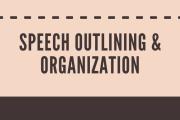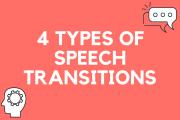The Speech Lab in Emerson College’s Department of Communication Studies offers tools and tips for executing successful presentations.
Tips for Speech Outlining and Organization
Here are some resources for outlining and organizing speeches.
The 5 Most Important Components
- Specific Purpose: A clear idea of what you are trying to achieve.
- For example: To inform my audience about the parks in Boston’s Emerald necklace.
To persuade my audience that Boston is better than New York.
- For example: To inform my audience about the parks in Boston’s Emerald necklace.
- Central Idea: Can you sum up your speech in one sentence? That’s your central idea/thesis.
- Main Points: Usually 2–4 that reflect the central idea. Sub-points and sub-sub points should support them. Continue to add sub-points as necessary and then transition into the next point.
- Transitions: Plan your transitions in advance and separate from the body. This helps the flow of your speech and keeps the audience engaged as they hear you moving from thought to thought.
- Patterns of Organization: The sub-points of your main idea may have a different organizational pattern than the speech itself, such as:
- Informative: topical, chronological, spatial, causal
- Persuasive: Monroe’s Motivated Sequence, problem solution, problem-case-solution, comparative advantages
5 Types of Informative Speeches
- Process: How to do something
- Object: Tangible thing such as an item or structure, even people or animals
- Concept: The most abstract type, including theories and beliefs
- Events: Includes anything that happens, not restricted to typical holidays or commemorations
- People/Places: Either/or!
Informative Organization
4 Ways to Organize Informative Speeches:
- Keeping it Fresh!
- Changing the type and organizational pattern allows the material to be extended and adapted for different audiences.
- Layer Up!
- Your organizational structure may be layered. For example, your speech may be organized topically but each main point may be organized chronologically.
- Chronological: In order of time or sequence
- Topical: By sub-topics of the larger topic
- Spatial: Show relationships, proximity, direction
- Causal: Show cause and effect
- Your organizational structure may be layered. For example, your speech may be organized topically but each main point may be organized chronologically.
Types of Speech Persuasion
Three questions to ask:
- Question of Fact: Is this assertion true or false?
- Example: To persuade my audience that recess helps students learn in the classroom.
- Question of Value: Is this assertion good or bad? Moral or immoral? Just or unjust?
- Example: To persuade my audience that eliminating recess is unfair to students and teachers.
- Question of Policy: Should a course of action be taken or not taken? Seeks either passive agreement or action.
- Example: To persuade my audience that eliminating recess is unfair to students and teachers.
- Example: To persuade my audience that eliminating recess is unfair to students and teachers.
Persuasion Organization
Questions of Fact and Value are usually organized topically, but there are four patterns of organization to organize a speech on the Question of Policy:
- Problem/Solution: Two main points
- Problem-Cause-Solution: Three main points. Use when the audience needs to know the cause of the problem in order to be persuaded that your solution is the best.
- Comparative Advantages: Compare solutions to the problem and persuade the audience that yours is the best course of action.
- Monroe’s Motivated Sequence: A five-step process where each step builds on the one before it to move the audience to action - attention, need, satisfaction, visualization, action. Often more narrative oriented.
4 Steps to Speech Organization
Do you have a great idea for your speech, but aren’t sure how to execute it? Use this handy guide to organize your thoughts into something that’s presentation-ready.
- Introduction: Make sure to include the following
- Attention-getter
- Credibility
- Topic reveal
- Preview of main points
- Full sentence transition if not included in preview
- Body: Use the body to discuss the key concepts of your speech:
- Name and explain your main point
- Use supporting evidence to back up your main point
- Use sub-points to strengthen your argument as necessary
- End with a full sentence transition to link to your main point
- For your next thoughts:
- Rinse and repeat! You need between two and five points to support your speech, so use the guide above and apply it to your concepts
- Tips: When it comes to sub-points, use as many as necessary to best support your argument. You may need more or less depending on the subject. Remember the rule of three!
- Conclusion: You’ve made it to the end of your speech. Make sure to close it with a bang!
- The conclusion should be 5% of your total presentation
- Summarize the main points of your speech
- End with a memorable closing!
Tips for Speech Delivery
Here are some resources for delivering speeches effectively.
Speech Delivery Basics
See the speech delivery basics as outlined below:
- Verbal Delivery: Changes in volume, rate and pitch help express emotion! For example, speaking faster and louder shows excitement, while speaking quieter and slower commands attention. Learn about the three main aspects of verbal speech delivery below.
- Vocal Variety: Find balance among the four factors of voice
- Pitch: the highs and lows of your voice
- Rate: how fast or slow you speak
- Loudness: volume, projection & emphasis
- Quality: improve upon your natural voice
- Pronunciation
- Check that you are pronouncing unfamiliar words correctly. If a word is still challenging after you practice it, replace it with a word you are more comfortable with.
- Articulation
- Speak clearly and enunciate your words.
- Vocal Variety: Find balance among the four factors of voice
- Non-Verbal Delivery: While you might be focused on the verbal aspects of your speech, non-verbal aspects of public speaking are just as important. Learn more about non-verbal speech delivery below.
- Stance: Your posture affects your credibility. Stand or sit straight with shoulders back, your back straight and feet apart on the floor and a hips-width apart. Make sure your tailbone is tucked and your stomach is in. This stance gives you confidence and breath control. Don’t slouch!
- Gestures: Practice your speech out loud to see what your hands do while you talk. If you don’t like to talk with your hands, hold notecards, a presentation clicker, or interact with visuals. Be natural!
- Countenance: Use your facial expressions to communicate and elicit the response you want from your audience. Your expressions must match your tone!
- Eye Contact: Scan the room, stop briefly to make direct eye contact with audience members when needed. Look at your audience, not above them!
- Appearance: Dress appropriately for the audience and occasion. Plan ahead and look sharp!
- Paralanguage: Paralanguage is the way you deliver your words, also known as tone. For more info, see vocal variety above. Remember the four factors of voice!
Using Imagery In Your Speech
Use concrete words people can picture. Show, don’t tell!
- Simile: Compares using “like” or “as”
- “A Republic whose history, like the path of just, is as the shinning light that shineth more and more unto the perfect day.” — William Jennings Bryan
- Metaphor: Refers to one thought by mentioning another
- “With this faith, we will be able to transform the jangling discords of our nation into a beautiful symphony of brotherhood.” — Rev. Martin Luther King, Jr.
- Allusion: Mentions idea indirectly
- “And I can pledge our nation to a goal: when we see that wounded traveler on the road to Jericho, we will not pass to the other side” — George W. Bush
- Personification: Concept is given human attributes
- “Once again, the heart of America is heavy. The spirit of America weeps for a tragedy that denies the very meaning of our land.” — Lyndon Baines Johnson
Using Rhythm in Your Speech
- Parallelism: The use of words and phrases that have similar grammatical structure.
- “And that government of the people, by the people, for the people, shall not perish from this earth. —Abraham Lincoln
- Repetition: Used in a speech when words or phrases are repeated.
- “We are a people in a quandary about the present. We are a people in search of our future. We are a people in search of a national community.” —Barbara Jordan
- Alliteration: Repetition of the same letter or sound at the beginning of adjacent words.
- “And our nation itself is testimony to the love our veterans have had for it and for us. All of which America stands is safe today because brave men and women have been the first to face the fire at freedom’s front. —Ronald Reagan
- Antithesis: Used when a phrase contrasts with or reverses a previously mentioned concept.
- “As he said many times, in many parts of the nation, to those he touched and those who sought to touch him: ‘Some men see things as they are and say why, I dream things that never were and say why not.’”. —Edward M. Kennedy
- “As he said many times, in many parts of the nation, to those he touched and those who sought to touch him: ‘Some men see things as they are and say why, I dream things that never were and say why not.’”. —Edward M. Kennedy
4 Types of Speech Transitions
- Simple Transitions: Signals to the audience that you are moving from one thought to another.
- “Now that we’ve established that a problem exists, let’s discuss solutions.”
- Internal Previews: Tell the audience what you are going to discuss next.
- “In order to better understand the problem, let’s explore the two main areas of the problem: emotional and financial.”
- Internal Summaries: Similar in detail to internal previews but summarizes what you just said.
- “Now that we understand how the problem is affecting us both financially and emotionally, we can turn to some solutions.”
- Signposts: Brief words or phrases that indicate where you are in the speech.
- “First, let’s discuss the financial situation.”
Use these words to build transitions!
- Contrast and examples: Although, including, except, if, yet, as long as, for example, unless, in the cast of, these include, such as, for instance
- Specificity and emphasis: In particular, especially, firstly, secondly, lastly, otherwise, unlike, within, apart from, despite, because, so
- Elaboration: Therefore, consequently, in other words, on the contrary, alternatively, as long as, comparing, obviously clearly, as well as, moreover, too
- Conclusion: In addition, furthermore, already, afterwards, next time, inside, to finish, as a result, to sum up, in conclusion, now that, finally
How to Beat Speech Anxiety
- Eliminate Perfectionism
- It’s okay to make mistakes! Learning to accept errors in your presentation will alleviate stress.
- Know Your Topic
- Being an expert on your subject will increase confidence and calm your nerves.
- Visualize
- Push out negativity and imagine doing a great job on your speech. Visualize your success!
- Exercise
- Performing light exercise before your presentation can relieve stress.
- Breathe
- Try rhythmic breathing for stress relief. Breathe in for 4 seconds, hold your breath for 7 and exhale for 8 seconds.
- Fuel Yourself
- Eat several hours before your speech. Don’t skip a meal or eat right before you present.
- Dress for Success
- Dress appropriately and comfortably for your speech. Looking your best will improve your confidence.
- Stand Up Straight
- Using good posture will help you look and feel more confident.
- Practice Movement
- Prepare the non-verbal aspects of your presentation. Practicing the physical elements of your speech will help you feel more confident on presentation day.
- Stretch
- Try stretching exercises before your speech to loosen tension and help you relax.










